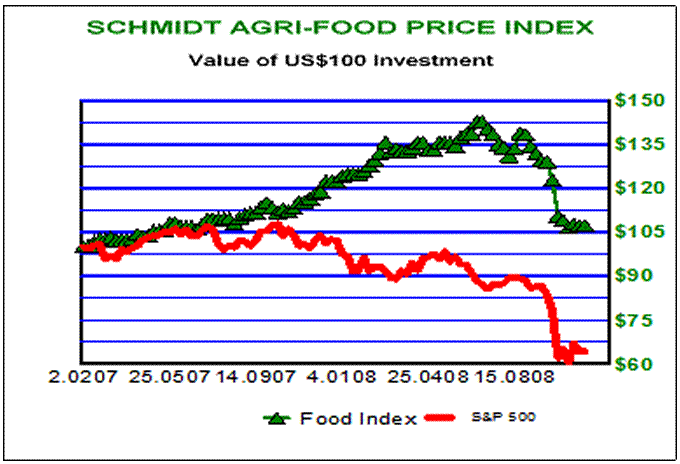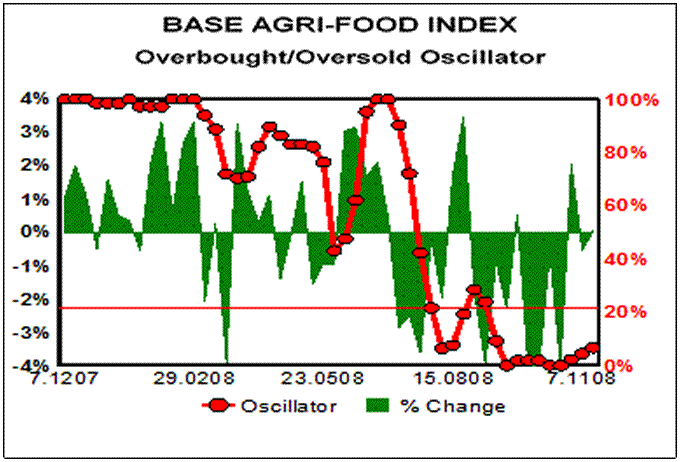Agri-Foods Long-term Opportunities Amidst Hedge Funds Deleveraging
Commodities / Agricultural Commodities Nov 09, 2008 - 04:27 PM GMTBy: Ned_W_Schmidt

 Despite ravages brought on by joyful liquidation of hedge fund industry, Agri-Food prices continue to show superior relative performance when compared to equities. That conclusion is readily apparent from this week's first graph. In it are plotted our Agri-Food price index and the S&P 500. As ignorance of complexity of commodities is widespread among investment community and in particular the business media, investors need to make an effort to be better informed. Commodities are both not a homogeneous asset class and an incredible investment opportunity.
Despite ravages brought on by joyful liquidation of hedge fund industry, Agri-Food prices continue to show superior relative performance when compared to equities. That conclusion is readily apparent from this week's first graph. In it are plotted our Agri-Food price index and the S&P 500. As ignorance of complexity of commodities is widespread among investment community and in particular the business media, investors need to make an effort to be better informed. Commodities are both not a homogeneous asset class and an incredible investment opportunity.

Second chart portrays the stochastic built on the Agri-Food Index. It had become deeply over sold as hedge funds were being liquidated, an otherwise joyous event despite the short-term pain inflicted, and the apparently good 2008 global grain harvest. That stochastic is starting to turn upward, indicating that the over sold condition may be weakening and an upward move in Agri-Food price is likely. The base is being built. With global grain production likely to fall in the 2009 crop year, the prospect for higher prices is excellent .

Commodities, as we said above, is not a homogenous asset class . Commodities includes (1) energy, such as oil and coal, (2) mineral ores, such as iron and copper, and (3) Agri-Foods, such as corn and rice. Each of the individual sectors is driven by different forces. GDP's real growth rate might drive the price for mineral ores like copper, but has little or nothing to do with the price of rice. Investors need to discriminate among these different sectors during this period when economists, strategists, and media commentators are spreading their ignorance of commodities . Remember that the driving forces for Agri-Foods is growing consumer income in China and India, and a shortage of productive farm land.
Greatest source of demand growth for Agri-Foods is coming from China, with India in the back stretch. China, contrary to the misinformation being spread by Street, is not plunging into a near depression as is the case with the United States and Canada. China's growth rate may slow, but the nation's economic size will still expand by more than $200 billion per year for some time . By definition, the income of China will grow by a like amount. A significant and material portion of that income growth will be spent on Agri-Food. The Chinese may consume less copper, but they are not likely to eat less with incomes expanding.
China is moving to stimulate domestic consumer demand . Their government fully understands that the crumbling U.S. economy will not permit continued over reliance on an export model. On that front, the government has announced an almost $600 billion stimulus plan for the domestic economy. That stimulus will bolster economic growth which will further raise incomes . As incomes rise, the demand for Agri-Foods increases. Remember, if the Chinese substitute one pound of pork for one pound of grain, demand for grain rises by five pounds . The Street still fails to comprehend that food does not come from a factory.
In a world where financial failures are causing economic growth to collapse, Agri-Food investments have positive fundamentals. With China's income continuing to grow , global grain production likely to fall in the coming year , and with global stock piles moving toward desperately low levels , Agri-Food is likely to be one of the few sources of investment gains in years ahead.
By Ned W Schmidt CFA, CEBS
Copyright © 2008 Ned W. Schmidt - All Rights Reserved
AGRI-FOOD THOUGHTS are from Ned W. Schmidt,CFA,CEBS, publisher of Agri-Food Value View , a monthly exploration of the Agri-Food grand cycle being created by China, India, and Eco-energy. To review the most recent issue go to http://home.att.net/~nwschmidt/READFOOD.html
Ned W Schmidt Archive |
© 2005-2022 http://www.MarketOracle.co.uk - The Market Oracle is a FREE Daily Financial Markets Analysis & Forecasting online publication.


